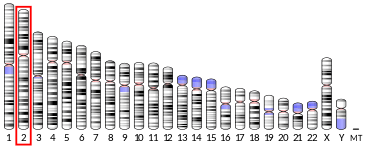LYPD6B
LY6/PLAUR Domain Containing 6B, also known under the name Cancer/Testis Antigen 116 (CTA116) and LYPD7 is encoded by the LYPD6B gene.[5] LYPD6B is a member of the lymphocyte antigen 6 (LY6) protein family. It is expressed in the testis, lungs, stomach and the prostate and in the nervous system where it acts as a modulator of nicotinic acetylcholine receptor activity.
Structure
The protein is 183 amino acids long and its molecular mass is 20.656.[6] The gene LYPD6B encoding the protein is located on chromosome 2 in humans.
Background
The protein was discovered for the first time in a 2009 study; its presence was detected in the cytoplasm and it was associated with activation of the AP-1 transcription factor.[7] LYPD6B is known as a prototoxin due to its structural similarity with the 3-fingered snake venom proteins α-bungarotoxin and cobratoxin.[8] As a prototoxin, LYPD6B also belongs to the protein family of Ly-6/urokinase plasminogen activator receptor (Ly6/uPAR). It has a 3-fingered motif secondary structure which appears due to the presence of 8–10 cysteine residues that facilitate disulfide bond formation.[8]
Role
The protein is expressed in the nervous system where it acts as an enhancer of the activity of the neurotransmitter acetylcholine certain α7-containing nicotinic acetylcholine receptors, which have a role in learning.[8] A duplication of the gene has been detected in a case study of two individuals with severe intellectual disability, suggesting its role in proper brain development and cognitive function.[9] Additionally, the protein demonstrates high expression in several other normal organs including the testis, lungs, stomach, and prostate.[10]
Hypermethylation of the gene and a subsequent decreased expression has been demonstrated as one of the contributors to the invasive capacity of cancer cells in melanoma.[11]
References
- GRCh38: Ensembl release 89: ENSG00000150556 - Ensembl, May 2017
- GRCm38: Ensembl release 89: ENSMUSG00000026765 - Ensembl, May 2017
- "Human PubMed Reference:". National Center for Biotechnology Information, U.S. National Library of Medicine.
- "Mouse PubMed Reference:". National Center for Biotechnology Information, U.S. National Library of Medicine.
- "Entrez Gene: LY6/PLAUR domain containing 6B". NCBI. Retrieved 21 July 2020.
- "UniProt, Q8NI32". Retrieved 23 July 2020.
- Ni J, Lang Q, Bai M, Zhong C, Chen X, Wan B, Yu L (April 2009). "Cloning and characterization of a human LYPD7, a new member of the Ly-6 superfamily". Molecular Biology Reports. 45 (11): 697–703. doi:10.1007/s11033-008-9231-6.
- Ochoa V, George AA, Nishi R, Whiteaker P (March 2016). "The prototoxin LYPD6B modulates heteromeric α3β4-containing nicotinic acetylcholine receptors, but not α7 homomers". FASEB Journal. 30 (3): 1109–19. doi:10.1096/fj.15-274548. PMC 4750422. PMID 26586467.
- Chung BH, Mullegama S, Marshall CR, Lionel AC, Weksberg R, Dupuis L, et al. (April 2012). "Severe intellectual disability and autistic features associated with microduplication 2q23.1". European Journal of Human Genetics. 20 (4): 398–403. doi:10.1038/ejhg.2011.199. PMC 3306850. PMID 22085900.
- Kong HK, Park JH (November 2012). "Characterization and function of human Ly-6/uPAR molecules". BMB Reports. 45 (11): 595–603. doi:10.5483/bmbrep.2012.45.11.210. PMC 4133805.
- Koroknai V, Szász I, Hernandez-Vargas H, Fernandez-Jimenez N, Cuenin C, Herceg Z, et al. (January 2020). "DNA hypermethylation is associated with invasive phenotype of malignant melanoma". Experimental Dermatology. 29 (1): 39–50. doi:10.1111/exd.14047. PMID 31602702.



